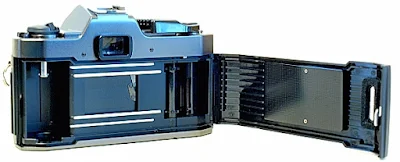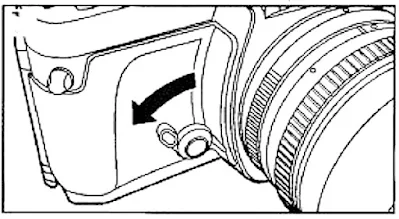Olympus made the curtain call on the production of the OM system cameras with the launch of the Olympus OM2000 in 1997. Sadly, though, the OM2000 was not off OM's own pedigree, but rather a lower-cost consumer-oriented model built by Cosina on a platform originally developed for the Cosina CT-1 (which is also what the Nikon FM10 and Canon T60 were all about).
First on the bucket list for the OM2000 was its design feature, which relies heavily, though it had manual controls and metering capabilities, on the use of the in Automatic Exposure (AE) mode. Next is a camera body not quite as robust when compared even to the OM-40, and gone is the connectivity to the rest of OM's system accessories and peripherals, aside from what can be attached via the lens mount.
Not without its merit, though, the OM2000 is still capable of delivering legendary quality images when mounted with Zuiko OM lenses and comes in a quite attractive, compact, and slightly sculptured rubberized body form with a gunmetal finish top and bottom plates. The OM2000 is capable of delivering a top stepped-control mechanical shutter speed of 1/2000 second, and the camera is equipped with both spot and center-weighted average metering functions.
Oly35mm Review - OM-2000
In 1997 Olympus commissioned Cosina to make an entry level manual camera to suit OM mount lenses. The result was the OM-2000; along with 35-70mm and 70-210mm lenses, and a small flash. Many Olympus enthusiasts disregard this model; however, it plays an important part in the winding down of 35mm cameras by the company.
To round off the consumer market orientation, the OM2000 was generally sold as a kit, with a close-focus S Zuiko Auto-Zoom 35-70mm 1:3.5~4.8 lens, which, by itself, is also a dichotomy of change. The lens has its aperture ring placed right back just off the mount, opposite to what we are used to. The lens was also made by Cosina.
Design and Build
The Olympus OM2000 is an Olympus OM-mount 35mm film SLR camera with a vertically-traveling travel mechanically controlled metal focal-plane shutter capable of a shutter speed range from 1 to 1/2000 second, and B. Flash synchronization is at 1/125 second. The film speed ISO range is 25-3200 in 1/3 steps increments.The camera is fitted with a switch-selectable center-weighted average and a spot metering system, which is measured off the rangefinder circle of the split-image microprism viewing screen. Exposure control is viewfinder readout by matching a green LED, spot metering mode is indicated by an orange LED, and the finder view field is 93% of the actual picture field.
The shutter release button is locked when the film advance crank is pushed right in. Pull the lever out slightly to release the lock.
Basic Camera Features
The Olympus OM2000 is rather good-looking with its gunmetal top and bottom plates, and the cut-out style sculptured rubberized body cover.The front of the camera is plain aside from the Self-Timer lever located on the lower-left corner of the lens mount housing. Different from the rest of the OM clan (except for the OM-10), the OM2000 does not have a shutter speed ring at the base of the lens mount.
On the left of the plate is the Film Rewind Crank, which is also the pull-up Film Back Release. Slightly in from the edge is the Spot Metering Selector lever. An accessory shoe sits on top of the pentaprism, and on its right, the Shutter Speed/pull-up Film ISO dial, Shutter Release Button, Film Advance Crank, Frame Counter, and Multiple Exposure Lever.
The back of the OM2000 is plain, with only the Viewfinder Eyepiece and a Film Window on the Film Back. The Film Back is a non-interchangeable hinge type.
Located on the bottom plate are the Battery Chamber Cover, Tripod Socket, and Rewind Release Button.
The film box is the Olympus Easy Load system with the standard film chamber, shutter opening, film advance sprocket, and slotted take-up spool. Make sure that the film lead is properly inserted into one of the slots of the take-up spool before closing the film back and taking the 2-blank shot to advance the film to Frame 1.
Viewfinder Readout
TTL metering is the center-weighted average, and Spot Metering is measured off the split-image microprism circle in the center of the screen.
Manual Exposure Mode
In manual exposure mode on the OM2000, shots are normally taken in 'shutter-priority' style. This is where you first set the shutter speed, frame, and focus the image, and half-press the shutter release button to activate the exposure meter. With the shutter button still half-pressed, adjust the lens aperture until the correct exposure is indicated by the green LED. Take the shot.Taking shots with the aperture setting intermediate between 2 aperture stops is possible with the OM2000.
You can also shoot the 'aperture-priority' style or do a depth-of-field shot by presetting the lens aperture setting first, and then the shutter speed before taking the shot. This might be a two-handed operation, with the left hand over and across the camera body to manipulate the shutter speed dial.
Using Spot Metering
While the sequence of taking a shot is the same as in manual exposure mode, using spot metering means that the exposure value is taken off the split-image/microprism circle in the middle of the viewing screen.This is useful in conditions where you want to take the exposure value of a specific spot within the image frame, say, to reduce the influence of backlight or other extraneous light sources from influencing the outcome of the exposure value.
Depth-of-Field Preview
The depth-of-field preview button is located on the lens barrel, across from the lens release lock.Multiple Exposure
To activate, pull the multiple exposure lever back while cranking the film advance lever. This action will cock the shutter without moving the film frame forward.
Self-Timer / Mirror Lock-up
You can also use the device on the OM2000 to lock up the mirror for a vibration-free shot. Place the camera on a hard surface or fix it on a tripod, release the shutter, and the mirror will flip up and fire after the delay is fully actuated. You can also use a cable release to trigger the shutter button.
Battery
The OM2000 requires a pair of SR44 or LR44 button cells to operate the metering system. The shutter system is mechanical and does not need batteries to operate.Camera Body Weight
The OM2000 camera's body weight is 405 grams without batteries.Using The Camera
As an avid user of the OM camera system, I sometimes wonder why I have not come across other manufacturers who have picked up on the idea of having a DoF (depth-of-field) preview button fitted to the barrel of the lens. Olympus, on the other hand, I found this to be very convenient and useful, and it seems to save a lot of design and engineering headaches of putting the mechanism within the design of the camera body.Having the DoF preview lever is, of course, the most distinct creative advantage of an OM system camera, regardless of the cost or consumer-level sector the camera was targeted for. Add a top shutter speed of 1/2000 second, spot metering facilities, and mirror lockup with self-timer activation, and you have the OM2000, a manual exposure version of the OM system just like the OM-1 bodies, but with a faster top speed and spot metering.
With a handy bodyweight of only 430 grams, and 185 grams additional with the S Zuiko Auto-Zoom 35-70mm f/1:3.5~4.5, the first variable aperture zoom from Olympus, the OM2000 is light and compact enough to be a use-any-time take-any-where camera. Take it along wherever you go, use it any time of the day, and use it until it lasts while enjoying the legendary quality of those Zuiko images.
The OM2000 may not be a great camera, but it is simply affordable and easy to come by. It is mechanical and is mechanically sound, and the metallic shutter will remind you of that, it is basic and will fit the new user to a T, it has a large viewfinder and easy controls, it has a fast top shutter speed, 1/125 second synchro, and a spot meter, and makes a good impression with its nice color and body shape.
A great camera for the beginner as well as the enthusiast, and a good buy, I would say.


























No comments:
Post a Comment